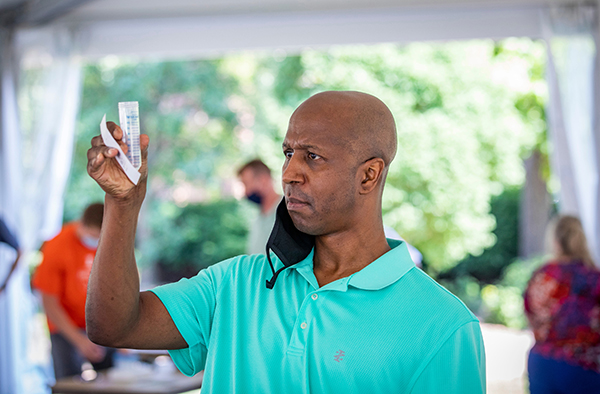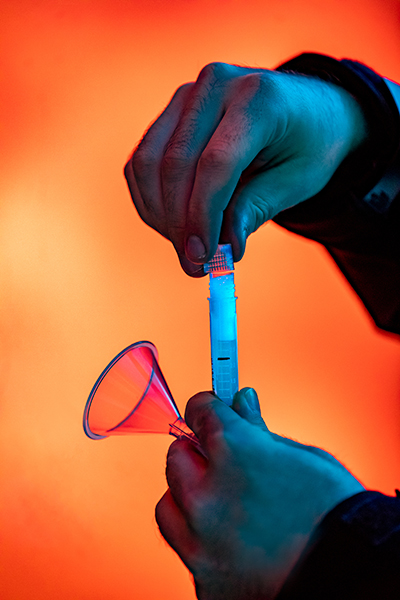Rapid antigen tests perform on par with lab tests when used every three days

Detecting SARS-CoV-2, the virus that causes COVID-19, improves with regularity of testing, whether using rapid antigen tests or PCR molecular tests. The PCR test is considered the gold standard for diagnosing COVID-19 infection, but cost and infrastructure issues, as well as wait times for PCR results, have limited its use more broadly as a screening tool for asymptomatic people because rapid results are needed to interrupt the chain of transmission.
In a highly anticipated study that compares rapid antigen and laboratory PCR approaches for COVID-19 serial screening, researchers affiliated with the National Institutes of Health’s Rapid Acceleration of Diagnostics (RADx) initiative reported results from 43 people infected with the virus. They found that both testing methods were equally effective in detecting SARS-CoV-2 infection when tests were given on a regular cadence every three days. While individual PCR tests are more sensitive than antigen tests, particularly early in infection, the results showed that both testing approaches can give 98% sensitivity when taken regularly as part of a screening program. Because antigen tests at the point of care or at home can deliver immediate results and are less costly than laboratory tests, these results suggest that they could be a highly effective screening tool to prevent disease outbreaks.
“Rapid antigen testing at home, two to three times per week, is a powerful and convenient way for individuals to screen for COVID-19 infection,” said Bruce Tromberg, Ph.D., director of the National Institute of Biomedical Imaging and Bioengineering (NIBIB), part of NIH. “With schools and businesses reopening, an individual’s risk of infection can change from day to day. Serial antigen testing can help people manage this risk and quickly take action to prevent spread of the virus.”
Dr. Tromberg leads the RADx Tech program, which supported the study. For the past year, the RADx initiative has been a catalyst for dozens of diagnostic device technologies—including both antigen and PCR tests—accelerating the development and commercialization of COVID-19 diagnostic tests.
Authors of the study in the June 30, 2021, Journal of Infectious Diseases, are researchers at the University of Illinois at Urbana-Champaign (UIUC); University of Massachusetts Medical School, Worcester; Johns Hopkins School of Medicine, Baltimore; and NIBIB.
Employees and students at UIUC participate in SHIELD Illinois, a COVID-19 screening program implemented this past year on campus. SHIELD Illinois participants who tested positive or lived in close contact with a person who received a positive result were invited to participate in this research study. The goal was to investigate the sensitivity of specific types of diagnostic tests during infection by having participants take PCR and antigen tests daily during the course of their infection. Daily samples were also tested for the presence of infectious virus as a measure of how easily individuals may transmit virus to others at different stages of infection.
The team began their participant recruitment in early December 2020, which continued into spring 2021. To capture daily test results across the entire course of infection, participants were enrolled within days after their exposure to the virus, having received negative test results in the seven days prior to enrollment. None of the participants in the study experienced symptoms that required hospitalization.

Participants supplied a saliva sample and two forms of nasal swabs for 14 consecutive days. A courier retrieved the samples daily. To obtain a rough measure of the period during which subjects could spread infection to others, the research team sent one of the nasal samples to a laboratory at Johns Hopkins University to observe the growth of live virus in culture. Viral culture is labor- and cost-intensive and is not practical for testing large numbers of people but provides a high degree of certainty that live virus can be derived from the sample. By culturing samples in this study, the researchers could estimate the onset and duration of COVID-19 infectiousness.
“Antigen tests and PCR tests detect the presence of different molecules found in virus particles,” explained Christopher B. Brooke, senior author and assistant professor of molecular and cell biology at UIUC. “Most tests detect genetic material associated with the virus, but that doesn’t mean there is live virus there. The only way to tell with certainty if live, infectious virus is present is to perform an infectivity assay, or culture,” such as was performed at the Johns Hopkins laboratory.
The researchers then compared three COVID-19 viral testing modalities—PCR testing of saliva, PCR testing of nasal samples and rapid antigen testing of nasal samples. The saliva sample results were performed with an authorized saliva-based PCR test developed at UIUC, called covidSHIELD, that can generate a result after about 12 hours. A separate PCR test performed with an Abbott Alinity device was used to obtain results from a nasal swab. Rapid antigen testing was performed using a Quidel Sofia SARS Antigen Fluorescent Immunoassay device that is authorized for use at the point of care and can generate a result after 15 minutes.
The researchers calculated the sensitivity of each test modality to detect SARS-CoV-2 and measured the presence of live virus over a two-week period following initial infection. They found that PCR molecular tests—both from saliva and nasal samples—are more sensitive than rapid antigen tests at detecting the SARS-CoV-2 virus prior to the infectious period. If the result from PCR tests could be quickly returned, the person receiving the result could undertake measures much sooner to prevent transmitting the virus to others. Unfortunately, results from PCR are rarely returned the day of testing.
The authors calculated test sensitivity based on test frequency, finding that a cadence of tests every three days achieved better than 98% sensitivity to detect infection, whether using rapid antigen tests or PCR tests. When they assessed frequency of testing once per week, nasal and saliva PCR testing sensitivity remained high, at around 98%, but antigen test sensitivity declined to 80%. These results show, for the first time, that testing at least twice per week with rapid antigen tests has comparable performance with PCR testing and maximizes the likelihood of detecting people infected with SARS-CoV-2.
The sensitivity of PCR molecular tests and rapid antigen tests is highest when viral cultures are positive for SARS-CoV-2, as might be expected. Even beyond this infectivity period, though, PCR tests continue to detect particles of virus, when the virus is most likely no longer transmissible.
“Silent transmission of the SARS-CoV-2 virus from individuals with no symptoms contributes significantly to the spread of the virus,” said co-author William Heetderks, M.D., Ph.D., a RADx Tech program advisor at NIBIB. “Faster, cheaper and broader testing with antigen tests can be a big help in the kind of large-scale screening scenarios that can find these silent transmitters.”
This study was funded by the NIH RADx-Tech program under 3U54 HL143541-02S2.
Article: Longitudinal assessment of diagnostic test performance over the course of acute SARS-CoV-2 infection. 2021. Journal of Infectious Diseases. DOI:10.1093/jid/jiab337.
###
About the National Institute of Biomedical Imaging and Bioengineering (NIBIB): NIBIB’s mission is to improve health by leading the development and accelerating the application of biomedical technologies. The Institute is committed to integrating engineering and physical science with biology and medicine to advance our understanding of disease and its prevention, detection, diagnosis, and treatment. NIBIB supports emerging technology research and development within its internal laboratories and through grants, collaborations, and training. More information is available at the NIBIB website.
About the National Institutes of Health (NIH): The National Institutes of Health, the nation's medical research agency, includes 27 Institutes and Centers and is a component of the U.S. Department of Health and Human Services. NIH is the primary federal agency conducting and supporting basic, clinical, and translational medical research, and is investigating the causes, treatments, and cures for both common and rare diseases. For more information about NIH and its programs, visit www.nih.gov.
